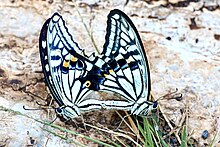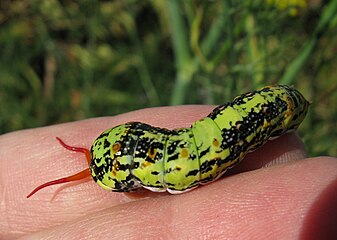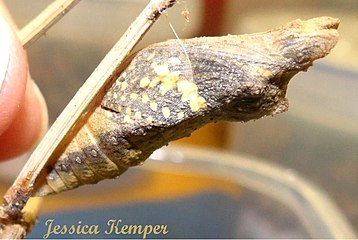
Papilio glaucus, the eastern tiger swallowtail, is a species of butterfly native to eastern North America. It is one of the most familiar butterflies in the eastern United States, ranging north to southern Ontario, Canada, and is common in many different habitats. It flies from spring until fall, during which it produces two to three broods. Adults feed on the nectar of many species of flowers, mostly from those of the families Apocynaceae, Asteraceae, and Fabaceae. P. glaucus has a wingspan measuring 7.9 to 14 cm. The male is yellow with four black "tiger stripes" on each forewing. Females may be either yellow or black, making them dimorphic. The yellow morph is similar to the male, but with a conspicuous band of blue spots along the hindwing, while the dark morph is almost completely black.

Swallowtail butterflies are large, colorful butterflies in the family Papilionidae, and include over 550 species. Though the majority are tropical, members of the family inhabit every continent except Antarctica. The family includes the largest butterflies in the world, the birdwing butterflies of the genus Ornithoptera.
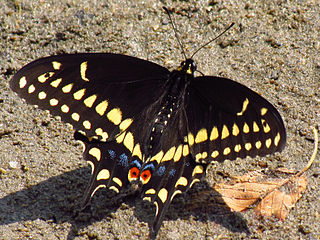
Papilio polyxenes, the (eastern) black swallowtail, American swallowtail or parsnip swallowtail, is a butterfly found throughout much of North America. An extremely similar-appearing species, Papilio joanae, occurs in the Ozark Mountains region, but it appears to be closely related to Papilio machaon, rather than P. polyxenes. The species is named after the figure in Greek mythology, Polyxena, who was the youngest daughter of King Priam of Troy. Its caterpillar is called the parsley worm because the caterpillar feeds on parsley.
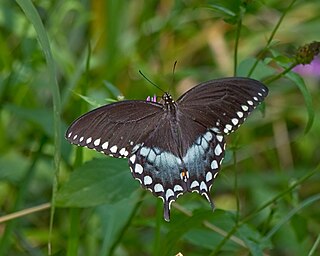
Papilio troilus, the spicebush swallowtail or green-clouded butterfly, is a common black swallowtail butterfly found in North America. It has two subspecies, Papilio troilus troilus and Papilio troilus ilioneus, the latter found mainly in the Florida peninsula. The spicebush swallowtail derives its name from its most common host plant, the spicebush, members of the genus Lindera.

The osmeterium is a defensive organ found in all papilionid larvae, in all stages. The organ is situated in the prothoracic segment and can be everted when the larva feels threatened. The everted organ resembles a fleshy forked tongue, and this along with the large eye-like spots on the body might be used to startle birds and small reptiles. The osmeterial organ remains inside the body in the thoracic region in an inverted position and is everted when the larva is disturbed in any way emitting a foul, disagreeable odor which serves to repel ants, small spiders and mantids. To humans, this odour is rather strong but not unpleasant, usually smelling like a concentrated scent of the caterpillar's food plant and pineapple.

Papilio rutulus, the western tiger swallowtail, is a swallowtail butterfly belonging to the Papilionidae family. The species was first described by Hippolyte Lucas in 1852.

Eurytides marcellus, the zebra swallowtail, is a swallowtail butterfly native to the eastern United States and south-eastern Canada. It is the state butterfly of Tennessee. Its distinctive wing shape and long tails make it easy to identify, and its black-and-white-striped pattern is reminiscent of a zebra. The butterflies are closely associated with pawpaws, and are rarely found far from these trees. The green or black caterpillars feed on the leaves of various pawpaw species, while the adults feed on flower nectar and minerals from damp soil.

Papilio demoleus is a common and widespread swallowtail butterfly. The butterfly is also known as the lime butterfly, lemon butterfly, lime swallowtail, and chequered swallowtail. These common names refer to their host plants, which are usually citrus species such as the cultivated lime. Unlike most swallowtail butterflies, it does not have a prominent tail. When the adult stage is taken into consideration, the lime swallowtail is the shortest-lived butterfly, with male adults dying after four days and females after a week. The butterfly is native to Asia and Australia, and can be considered an invasive pest in other parts of the world. The butterfly has spread to Hispaniola island in the Western Hemisphere, and to Mahé, Seychelles.

Papilio polymnestor, the blue Mormon, is a large swallowtail butterfly found in south India and Sri Lanka. It is the "state butterfly" of the Indian state of Maharashtra. With a wingspan of 120–150 mm, it is the fourth largest butterfly of India.

The giant swallowtail is the largest butterfly in North America. It is abundant through many parts of eastern North America; populations from western North America and down into Panama are now considered to belong to a different species, Papilio rumiko. Though it is often valued in gardens for its striking appearance, its larval stage can be a serious pest to citrus farms, which has earned its caterpillars the names orange dog or orange puppy. The giant swallowtail caterpillars possess remarkable camouflage from predators by closely resembling bird droppings. They use this, along with their osmeteria, to defend against predators such as wasps, flies, and vertebrates.

Papilio aegeus, the orchard swallowtail butterfly or large citrus butterfly is a species of butterfly from the family Papilionidae, that is found in eastern Australia and Papua New Guinea.
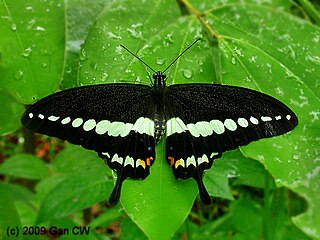
Papilio demolion, the banded swallowtail, is a species of swallowtail butterfly belonging to the family Papilionidae.
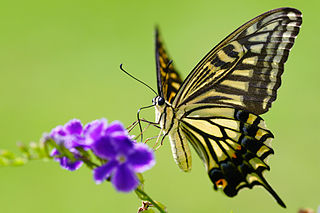
Papilio xuthus, the Asian swallowtail, Chinese yellow swallowtail, Japanese Swallowtail, or Xuthus swallowtail, is a yellow-colored, medium to large sized swallowtail butterfly found in northeast Asia, northern Myanmar, southern China, Taiwan, the Korean Peninsula, Japan, Siberia and the Hawaiian Islands. The butterfly has been observed once in Dunedin, New Zealand in 1996 emerging from a chrysalis in a car yard specializing in Japanese used cars; it is thought the chrysalis arrived through one of the cars. It was also recorded in the state of Arunachal Pradesh, India, in 2014.

Papilio anactus, the dainty swallowtail, dingy swallowtail or small citrus butterfly is a medium-sized butterfly from the family Papilionidae, that is endemic to Australia.

Papilio appalachiensis, the Appalachian tiger swallowtail, is a species of swallowtail butterfly found in eastern North America, particularly in the Appalachian Mountains. It is a hybrid of another two Papilio species, Papilio canadensis and Papilio glaucus, with which it shares many characteristics. The butterflies are normally yellow and contain black patterns in their wings. Their wingspans range from 86 to 115 mm. The caterpillars range in color from green and yellow to orange and are ornamented with black specks that give them the appearance of a bird dropping, which is useful for camouflage, or a large eye, a form of mimicry that is also efficient for protection. This species is univoltine. Females lay their eggs in May.

Cressida cressida, the clearwing swallowtail or big greasy, is a Troidine swallowtail butterfly found in northern Australia, New Guinea, Maluku, and Timor. It is in the monotypic genus Cressida.

Papilio palamedes, the Palamedes swallowtail or laurel swallowtail, is a North American butterfly in the family Papilionidae.

Papilio aristodemus, the Schaus' swallowtail or island swallowtail, is a species of American butterfly in the family Papilionidae. It is found in southern Florida in the United States and throughout the West Indies. It is named in honor of William Schaus.

Bicyclus anynana is a small brown butterfly in the family Nymphalidae, the most globally diverse family of butterflies. It is primarily found in eastern Africa from southern Sudan to Eswatini. It is found mostly in woodland areas and flies close to the ground. Male wingspans are 35–40 mm and female wingspans are 45–49 mm.

Papilio rumiko is a species of swallowtail butterfly. It is found from the south-western United States, through Mexico, El Salvador, Honduras, Costa Rica to Panama. The northernmost record is north-eastern Colorado.





